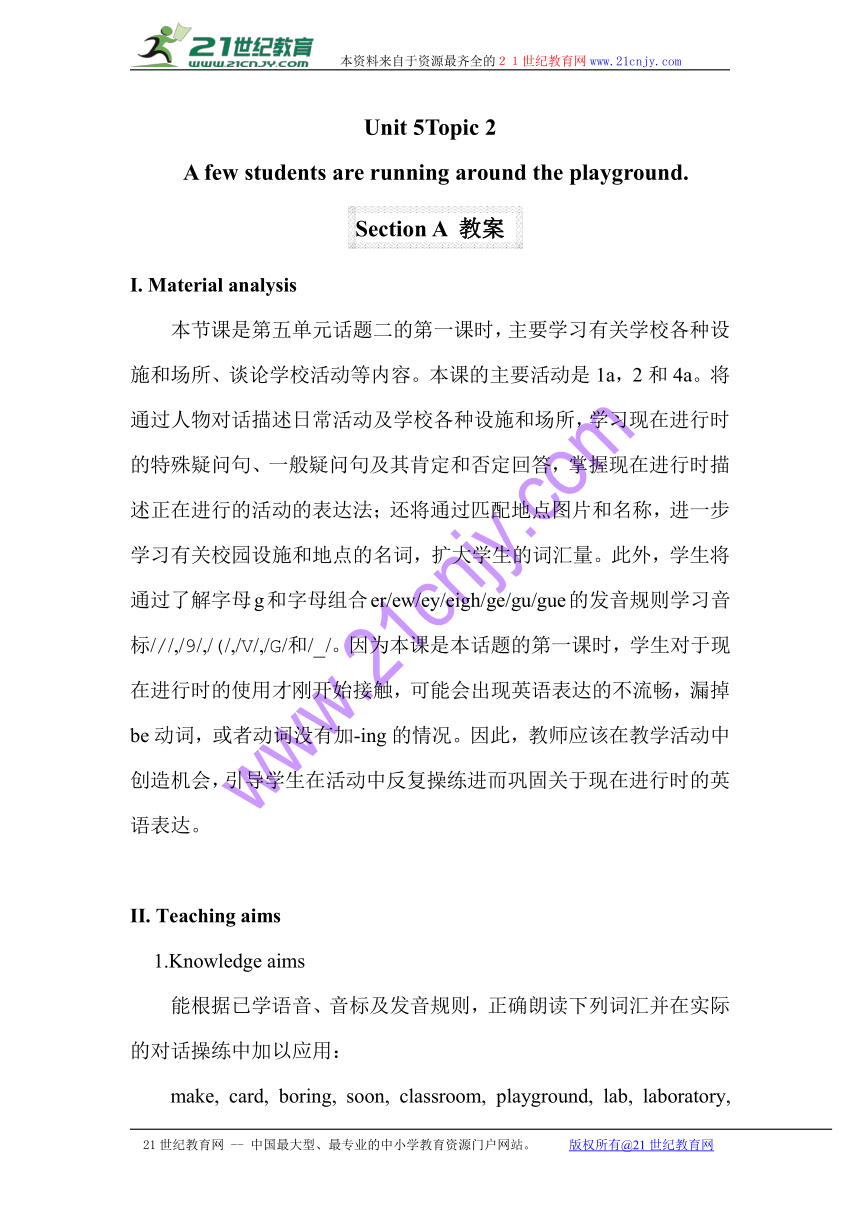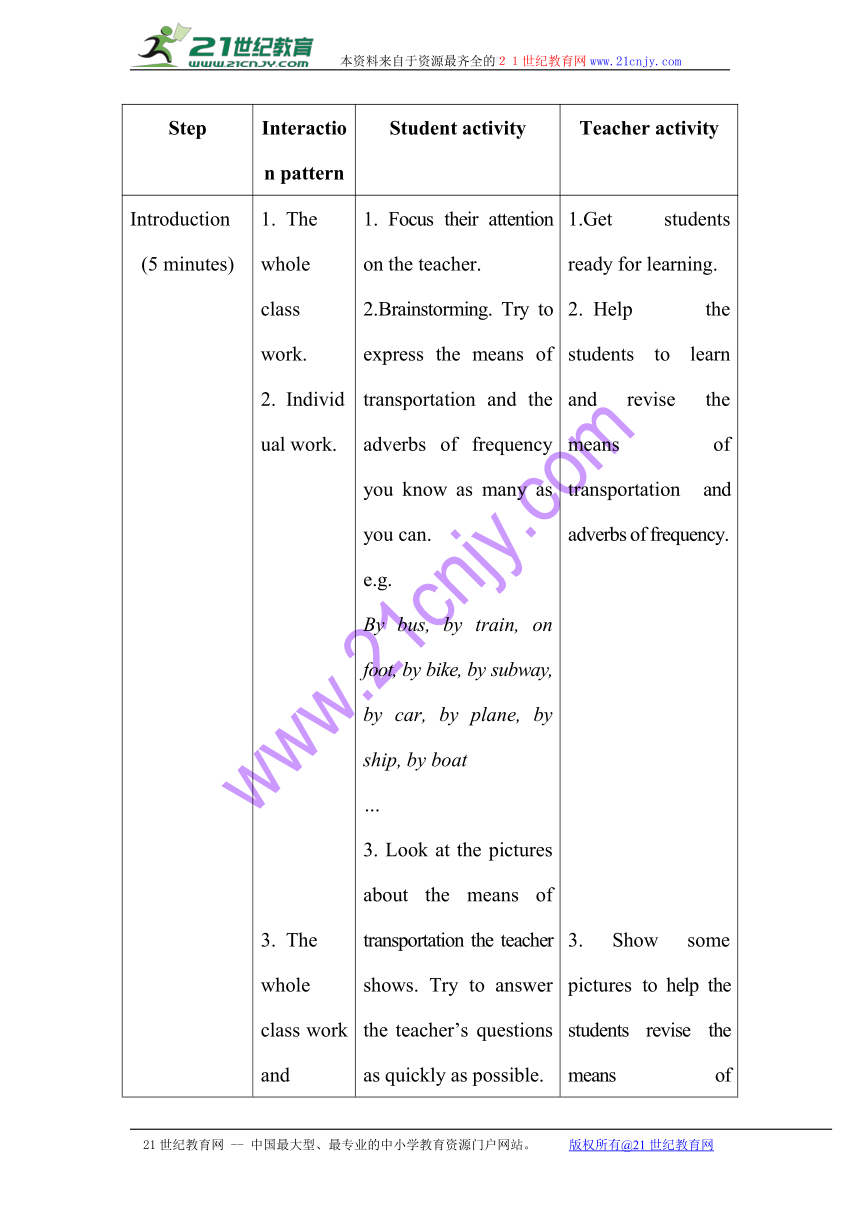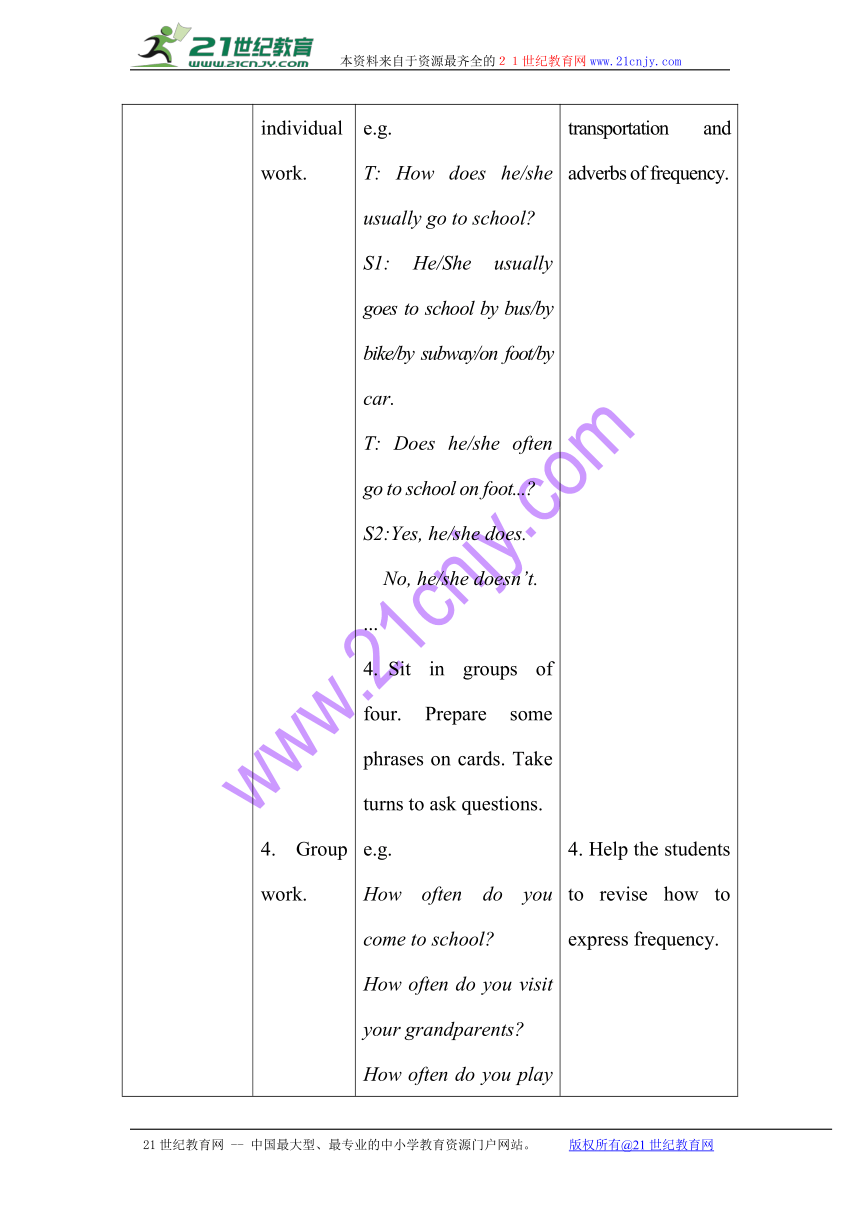Unit 5 Our school life Topic 2 A few students are running around the playground Section A 教案
文档属性
| 名称 | Unit 5 Our school life Topic 2 A few students are running around the playground Section A 教案 |  | |
| 格式 | zip | ||
| 文件大小 | 124.6KB | ||
| 资源类型 | 教案 | ||
| 版本资源 | 科普版 | ||
| 科目 | 英语 | ||
| 更新时间 | 2016-12-16 20:31:07 | ||
图片预览





文档简介
本资料来自于资源最齐全的21世纪教育网www.21cnjy.com
Unit
5Topic
2
A
few
students
are
running
around
the
playground.
Section
A
教案
I.
Material
analysis
本节课是第五单元话题二的第一课时,主要学习有关学校各种设施和场所、谈论学校活动等内容。本课的主要活动是1a,2和4a。将通过人物对话描述日常活动及学校各种设施和场所,学习现在进行时的特殊疑问句、一般疑问句及其肯定和否定回答,掌握现在进行时描述正在进行的活动的表达法;还将通过匹配地点图片和名称,进一步学习有关校园设施和地点的名词,扩大学生的词汇量。此外,学生将通过了解字母g和字母组合er/ew/ey/eigh/ge/gu/gue的发音规则学习音标///,/9/,/(/,/V/,/G/和/_/。因为本课是本话题的第一课时,学生对于现在进行时的使用才刚开始接触,可能会出现英语表达的不流畅,漏掉be动词,或者动词没有加-ing的情况。因此,教师应该在教学活动中创造机会,引导学生在活动中反复操练进而巩固关于现在进行时的英语表达。21世纪教育网版权所有
II.
Teaching
aims
1.Knowledge
aims
能根据已学语音、音标及发音规则,正确朗读下列词汇并在实际的对话操练中加以应用:
make,
card,
boring,
soon,
classroom,
playground,
lab,
laboratory,
computer,
room,
hall,
dining
hall,
gym,
gymnasium,
building,
swimming,
pool,
clean,
do
some
cleaning,
run,
dance21教育网
学生在小组合作活动中,能掌握字母g和字母组合er/ew/ey/eigh/ge/gu/gue的发音规则,学习音标///,/9/,/(/,/V/,/G/和/_/的发音;21cnjy.com
在情景对话中,能正确运用be+v.-ing来表达现在进行时,包括各种人称的肯定句、特殊疑问句、一般疑问句及其肯定和否定回答,如:21·cn·jy·com
(1)
—Are
you
doing
your
homework
—No,
I’m
not.
(2)
—Are
you
watching
TV
—Yes,
I
am.
(3)
I
am
making
cards.
(4)
—What
are
they
doing
now
—They
are
...
(5)
—Are
Wang
Wei
and
Lin
Tao
dancing,
too?
—No,
they
aren’t.
They
are
...
能就谈论校园生活的话题进行交流与对话操练。
2.
Skill
aims
能听懂谈论正在进行的动作的简单对话或叙述;
能说出学校各种设施和场所的名称;
能在口头表达中做到发音清晰、语音语调准确;
能根据字母组合和音标初步地进行单词拼读;
能根据图片信息书面描述正在进行的活动。
3.
Emotional
aims
通过谈论校园中正在进行的丰富多彩的活动,使学生发现校园生活的乐趣,从而培养学生热爱校园生活、乐于参加学校各种活动的意识;www.21-cn-jy.com
通过和他人共同完成任务,培养学生的合作精神。
III.
The
key
points
and
difficult
points
1.在小组合作活动中,能掌握字母g和字母组合er/ew/ey/eigh/ge/gu/gu的发音规则,学习///,/9/,/(/,/V/,/G/和/_/的发音;
2.在情景对话中,能正确运用be+v.-ing来表达现在进行时,包括各种人称的特殊疑问句、一般疑问句及其肯定和否定回答。
IV.
Learning
strategies
1.能够清楚、大声地进行朗读,认真听录音,反复模仿;
2.能够利用现实生活中的学习资源,如图书馆等。
V.
Teaching
aids
多媒体、录音机、教学挂图和黑板
VI.
Teaching
procedures
Step
Interaction
pattern
Student
activity
Teacher
activity
Introduction
(5
minutes)
The
whole
class
work.Individual
work.The
whole
class
work
and
individual
work.4.
Group
work.
Focus
their
attention
on
the
teacher.2.Brainstorming.
Try
to
express
the
means
of
transportation
and
the
adverbs
of
frequency
you
know
as
many
as
you
can.
e.g.
By
bus,
by
train,
on
foot,
by
bike,
by
subway,
by
car,
by
plane,
by
ship,
by
boat…
3.
Look
at
the
pictures
about
the
means
of
transportation
the
teacher
shows.
Try
to
answer
the
teacher’s
questions
as
quickly
as
possible.e.g.T:
How
does
he/she
usually
go
to
school S1:
He/She
usually
goes
to
school
by
bus/by
bike/by
subway/on
foot/by
car.T:
Does
he/she
often
go
to
school
on
foot... S2:Yes,
he/she
does.
No,
he/she
doesn’t....Sit
in
groups
of
four.
Prepare
some
phrases
on
cards.
Take
turns
to
ask
questions.e.g.How
often
do
you
come
to
school How
often
do
you
visit
your
grandparents How
often
do
you
play
basketball Do
you
go
to
the
library
three
times
a
week Do
you
listen
to
music
every
day ...
1.Get
students
ready
for
learning.Help
the
students
to
learn
and
revise
the
means
of
transportation
and
adverbs
of
frequency.3.
Show
some
pictures
to
help
the
students
revise
the
means
of
transportation
and
adverbs
of
frequency.4.
Help
the
students
to
revise
how
to
express
frequency.
Presentation
(10
minutes)
Individual
work
and
pair
work.The
whole
class
work.3.Individual
work
and
pair
work.Individual
work
and
group
work.
Do
2.
Look
at
the
pictures
in
2.
Learn
the
words
of
school
facilities.
Then
match
the
places
with
the
correct
words
or
phrases.
Check
the
answers
with
your
partner.Play
a
word
game:
“What’s
missing ”
Some
words
and
pictures
may
disappear.
Try
to
guess
what
is
missing
as
quickly
as
you
can.
Look
at
the
pictures
in
1a.
Read
the
sentences
in
1b.
Try
to
predict
the
listening
material
in
1a.
Then
listen
and
circle
the
correct
answers
in
1b
individually.
Check
the
answers
with
your
partner.Listen
to
1a
again
and
fill
in
the
blanks.
After
that,
open
your
books
and
check
your
answers.Michael:
Hello,
Jane!
This
is
Michael.
What
______
you
______
now Jane:
Guess!Michael:
Are
you
____
your
_____ Jane:
No,
I
am
not.Michael:
Are
you
_____
______ Jane:
Yes,
I
am.
What
about
you Michael:
I’m
______
cards,
but
it’s
______.Would
you
like
to
play
________ Jane:
Good
idea!
See
you
soon!Michael:
See
you!Then
discuss
in
groups.
Try
to
find
the
rules
of
the
“Present
Continuous”—be+v.-ing.e.g.…are
doing…are
watching
TV…is
making
cards
Present
new
words
of
school
facilities
with
the
help
of
the
pictures.
Check
the
answers.To
be
a
game
controller.Help
the
students
learn
to
predict
before
listening.
Play
the
tape
recorder
and
check
the
answers.4.
Play
the
tape
recorder.
Help
the
students
learn
to
listen
to
specific
information
and
to
summarize
the
grammar
rules
by
themselves.
Consolidation
(10
minutes)
Pair
work.The
whole
class
work
and
individual
work.
Practice
the
conversation
in
1a
in
pairs.
Look
at
the
pictures
shown
by
the
teacher
and
answer
the
teacher’s
questions:(1)What
is
he/she
doing (2)Is
he/she
playing
basketball (3)Are
you/they
doing
your/their
homework
1.
To
be
a
good
listener.
Help
the
students
consolidate
the
Present
Continuous
in
different
sentence
patterns.
Practice(10
minutes)
Individual
work
and
the
whole
class
work.Pair
work.Individual
work
and
group
work.4.Individual
work
and
pair
work.
Do
3a.
Listen
to
the
tape
and
match.
Pay
attention
to
the
structure
of
the
Present
Continuous.
The
whole
class
read
the
sentences
together
and
check
the
answers
at
the
same
time.Do
3b.
Work
in
pairs.
Make
up
conversations
with
the
information
in
3a.
Practice
in
pairs.
Then
some
pairs
act
out
your
conversations
to
the
whole
class.Do
4a.
Divide
the
class
into
six
groups.
Every
group
reads
one
group
of
words.
Discuss
in
groups
and
find
the
rules
of
sounds
about
er,ew,ey/eigh,g,ge,gu/
gue
by
yourselves.
Then
one
student
in
each
group
reads
out
the
sound
and
teaches
the
sound
to
the
whole
class.
Then
the
whole
class
listen
to
the
tape
recorder
and
check
the
sounds.
Read
the
sounds
and
words
aloud
after
the
tape.4.
Do
4b.
Try
to
read
the
words
in
4b.
Read
aloud
individually.
Compare
the
sounds
with
colored
letters.
Discuss
with
your
partner.
Play
the
tape
recorder
and
check
the
answers.Help
the
students
to
express
correctly.3.
Make
the
students
learn
to
help
each
other
and
learn
from
each
other.4.
Correct
their
sounds
while
they
are
reading.
Consolidate
the
sounds,
/1-e/;
/9-//;
/G-_/.
Production
(10
minutes)
Group
work.
Separate
the
class
into
three
groups.
One
group
writes
down
the
names,
one
writes
places
and
the
third
one
writes
down
the
actions.
Then
some
students
try
to
organize
the
sentences
with
the
places,
the
actions
and
the
names,
using
the
“Present
Continuous”.
1.Make
sure
the
students
know
how
to
express
the
“Present
Continuous”.2.Assign
the
homework:Review
the
words
and
practice
the
conversations
in
Section
A
with
your
partner;Make
up
a
new
conversation
similar
to
1a
with
your
partner.
Then
report
it
to
the
class
the
next
day;Preview
Section
B-1a.
Teaching
reflection:
在本节课中,学生学会了结合现在进行时描述正在进行的活动的表达法,学习了有关校园设施和地点的名词,学习了字母g和字母组合er/ew/ey/eigh/ge/gu
/gue的发音规则。但是由于语用习惯的关系,学生在用“be+v.-ing”的表达方式时偶尔会出现少了一个be动词的错误表达。因此教师应在学生的口头操练中加以纠正,帮助学生养成正确的语用习惯。
VII.
Blackboard
design
Topic
2
A
few
students
are
running
around
the
playground.Section
A1.—Are
you
doing
your
homework
make
—No,
I’m
not.
card
2.—Are
you
watching
TV
boring
—Yes,
I
am.
soon
3.
I
am
making
cards.
classroom
4.—What
are
they
doing
now
playground
—They
are...
lab=laboratory5.—Are
Wang
Wei
and
Lin
Tao
dancing,
too
computer—No,
they
aren’t.
They
are
...
room
hall
dining
hall
gym
building
swimming
pool
clean
do
some
cleaning
run
dance
21世纪教育网
--
中国最大型、最专业的中小学教育资源门户网站。
版权所有@21世纪教育网
Unit
5Topic
2
A
few
students
are
running
around
the
playground.
Section
A
教案
I.
Material
analysis
本节课是第五单元话题二的第一课时,主要学习有关学校各种设施和场所、谈论学校活动等内容。本课的主要活动是1a,2和4a。将通过人物对话描述日常活动及学校各种设施和场所,学习现在进行时的特殊疑问句、一般疑问句及其肯定和否定回答,掌握现在进行时描述正在进行的活动的表达法;还将通过匹配地点图片和名称,进一步学习有关校园设施和地点的名词,扩大学生的词汇量。此外,学生将通过了解字母g和字母组合er/ew/ey/eigh/ge/gu/gue的发音规则学习音标///,/9/,/(/,/V/,/G/和/_/。因为本课是本话题的第一课时,学生对于现在进行时的使用才刚开始接触,可能会出现英语表达的不流畅,漏掉be动词,或者动词没有加-ing的情况。因此,教师应该在教学活动中创造机会,引导学生在活动中反复操练进而巩固关于现在进行时的英语表达。21世纪教育网版权所有
II.
Teaching
aims
1.Knowledge
aims
能根据已学语音、音标及发音规则,正确朗读下列词汇并在实际的对话操练中加以应用:
make,
card,
boring,
soon,
classroom,
playground,
lab,
laboratory,
computer,
room,
hall,
dining
hall,
gym,
gymnasium,
building,
swimming,
pool,
clean,
do
some
cleaning,
run,
dance21教育网
学生在小组合作活动中,能掌握字母g和字母组合er/ew/ey/eigh/ge/gu/gue的发音规则,学习音标///,/9/,/(/,/V/,/G/和/_/的发音;21cnjy.com
在情景对话中,能正确运用be+v.-ing来表达现在进行时,包括各种人称的肯定句、特殊疑问句、一般疑问句及其肯定和否定回答,如:21·cn·jy·com
(1)
—Are
you
doing
your
homework
—No,
I’m
not.
(2)
—Are
you
watching
TV
—Yes,
I
am.
(3)
I
am
making
cards.
(4)
—What
are
they
doing
now
—They
are
...
(5)
—Are
Wang
Wei
and
Lin
Tao
dancing,
too?
—No,
they
aren’t.
They
are
...
能就谈论校园生活的话题进行交流与对话操练。
2.
Skill
aims
能听懂谈论正在进行的动作的简单对话或叙述;
能说出学校各种设施和场所的名称;
能在口头表达中做到发音清晰、语音语调准确;
能根据字母组合和音标初步地进行单词拼读;
能根据图片信息书面描述正在进行的活动。
3.
Emotional
aims
通过谈论校园中正在进行的丰富多彩的活动,使学生发现校园生活的乐趣,从而培养学生热爱校园生活、乐于参加学校各种活动的意识;www.21-cn-jy.com
通过和他人共同完成任务,培养学生的合作精神。
III.
The
key
points
and
difficult
points
1.在小组合作活动中,能掌握字母g和字母组合er/ew/ey/eigh/ge/gu/gu的发音规则,学习///,/9/,/(/,/V/,/G/和/_/的发音;
2.在情景对话中,能正确运用be+v.-ing来表达现在进行时,包括各种人称的特殊疑问句、一般疑问句及其肯定和否定回答。
IV.
Learning
strategies
1.能够清楚、大声地进行朗读,认真听录音,反复模仿;
2.能够利用现实生活中的学习资源,如图书馆等。
V.
Teaching
aids
多媒体、录音机、教学挂图和黑板
VI.
Teaching
procedures
Step
Interaction
pattern
Student
activity
Teacher
activity
Introduction
(5
minutes)
The
whole
class
work.Individual
work.The
whole
class
work
and
individual
work.4.
Group
work.
Focus
their
attention
on
the
teacher.2.Brainstorming.
Try
to
express
the
means
of
transportation
and
the
adverbs
of
frequency
you
know
as
many
as
you
can.
e.g.
By
bus,
by
train,
on
foot,
by
bike,
by
subway,
by
car,
by
plane,
by
ship,
by
boat…
3.
Look
at
the
pictures
about
the
means
of
transportation
the
teacher
shows.
Try
to
answer
the
teacher’s
questions
as
quickly
as
possible.e.g.T:
How
does
he/she
usually
go
to
school S1:
He/She
usually
goes
to
school
by
bus/by
bike/by
subway/on
foot/by
car.T:
Does
he/she
often
go
to
school
on
foot... S2:Yes,
he/she
does.
No,
he/she
doesn’t....Sit
in
groups
of
four.
Prepare
some
phrases
on
cards.
Take
turns
to
ask
questions.e.g.How
often
do
you
come
to
school How
often
do
you
visit
your
grandparents How
often
do
you
play
basketball Do
you
go
to
the
library
three
times
a
week Do
you
listen
to
music
every
day ...
1.Get
students
ready
for
learning.Help
the
students
to
learn
and
revise
the
means
of
transportation
and
adverbs
of
frequency.3.
Show
some
pictures
to
help
the
students
revise
the
means
of
transportation
and
adverbs
of
frequency.4.
Help
the
students
to
revise
how
to
express
frequency.
Presentation
(10
minutes)
Individual
work
and
pair
work.The
whole
class
work.3.Individual
work
and
pair
work.Individual
work
and
group
work.
Do
2.
Look
at
the
pictures
in
2.
Learn
the
words
of
school
facilities.
Then
match
the
places
with
the
correct
words
or
phrases.
Check
the
answers
with
your
partner.Play
a
word
game:
“What’s
missing ”
Some
words
and
pictures
may
disappear.
Try
to
guess
what
is
missing
as
quickly
as
you
can.
Look
at
the
pictures
in
1a.
Read
the
sentences
in
1b.
Try
to
predict
the
listening
material
in
1a.
Then
listen
and
circle
the
correct
answers
in
1b
individually.
Check
the
answers
with
your
partner.Listen
to
1a
again
and
fill
in
the
blanks.
After
that,
open
your
books
and
check
your
answers.Michael:
Hello,
Jane!
This
is
Michael.
What
______
you
______
now Jane:
Guess!Michael:
Are
you
____
your
_____ Jane:
No,
I
am
not.Michael:
Are
you
_____
______ Jane:
Yes,
I
am.
What
about
you Michael:
I’m
______
cards,
but
it’s
______.Would
you
like
to
play
________ Jane:
Good
idea!
See
you
soon!Michael:
See
you!Then
discuss
in
groups.
Try
to
find
the
rules
of
the
“Present
Continuous”—be+v.-ing.e.g.…are
doing…are
watching
TV…is
making
cards
Present
new
words
of
school
facilities
with
the
help
of
the
pictures.
Check
the
answers.To
be
a
game
controller.Help
the
students
learn
to
predict
before
listening.
Play
the
tape
recorder
and
check
the
answers.4.
Play
the
tape
recorder.
Help
the
students
learn
to
listen
to
specific
information
and
to
summarize
the
grammar
rules
by
themselves.
Consolidation
(10
minutes)
Pair
work.The
whole
class
work
and
individual
work.
Practice
the
conversation
in
1a
in
pairs.
Look
at
the
pictures
shown
by
the
teacher
and
answer
the
teacher’s
questions:(1)What
is
he/she
doing (2)Is
he/she
playing
basketball (3)Are
you/they
doing
your/their
homework
1.
To
be
a
good
listener.
Help
the
students
consolidate
the
Present
Continuous
in
different
sentence
patterns.
Practice(10
minutes)
Individual
work
and
the
whole
class
work.Pair
work.Individual
work
and
group
work.4.Individual
work
and
pair
work.
Do
3a.
Listen
to
the
tape
and
match.
Pay
attention
to
the
structure
of
the
Present
Continuous.
The
whole
class
read
the
sentences
together
and
check
the
answers
at
the
same
time.Do
3b.
Work
in
pairs.
Make
up
conversations
with
the
information
in
3a.
Practice
in
pairs.
Then
some
pairs
act
out
your
conversations
to
the
whole
class.Do
4a.
Divide
the
class
into
six
groups.
Every
group
reads
one
group
of
words.
Discuss
in
groups
and
find
the
rules
of
sounds
about
er,ew,ey/eigh,g,ge,gu/
gue
by
yourselves.
Then
one
student
in
each
group
reads
out
the
sound
and
teaches
the
sound
to
the
whole
class.
Then
the
whole
class
listen
to
the
tape
recorder
and
check
the
sounds.
Read
the
sounds
and
words
aloud
after
the
tape.4.
Do
4b.
Try
to
read
the
words
in
4b.
Read
aloud
individually.
Compare
the
sounds
with
colored
letters.
Discuss
with
your
partner.
Play
the
tape
recorder
and
check
the
answers.Help
the
students
to
express
correctly.3.
Make
the
students
learn
to
help
each
other
and
learn
from
each
other.4.
Correct
their
sounds
while
they
are
reading.
Consolidate
the
sounds,
/1-e/;
/9-//;
/G-_/.
Production
(10
minutes)
Group
work.
Separate
the
class
into
three
groups.
One
group
writes
down
the
names,
one
writes
places
and
the
third
one
writes
down
the
actions.
Then
some
students
try
to
organize
the
sentences
with
the
places,
the
actions
and
the
names,
using
the
“Present
Continuous”.
1.Make
sure
the
students
know
how
to
express
the
“Present
Continuous”.2.Assign
the
homework:Review
the
words
and
practice
the
conversations
in
Section
A
with
your
partner;Make
up
a
new
conversation
similar
to
1a
with
your
partner.
Then
report
it
to
the
class
the
next
day;Preview
Section
B-1a.
Teaching
reflection:
在本节课中,学生学会了结合现在进行时描述正在进行的活动的表达法,学习了有关校园设施和地点的名词,学习了字母g和字母组合er/ew/ey/eigh/ge/gu
/gue的发音规则。但是由于语用习惯的关系,学生在用“be+v.-ing”的表达方式时偶尔会出现少了一个be动词的错误表达。因此教师应在学生的口头操练中加以纠正,帮助学生养成正确的语用习惯。
VII.
Blackboard
design
Topic
2
A
few
students
are
running
around
the
playground.Section
A1.—Are
you
doing
your
homework
make
—No,
I’m
not.
card
2.—Are
you
watching
TV
boring
—Yes,
I
am.
soon
3.
I
am
making
cards.
classroom
4.—What
are
they
doing
now
playground
—They
are...
lab=laboratory5.—Are
Wang
Wei
and
Lin
Tao
dancing,
too
computer—No,
they
aren’t.
They
are
...
room
hall
dining
hall
gym
building
swimming
pool
clean
do
some
cleaning
run
dance
21世纪教育网
--
中国最大型、最专业的中小学教育资源门户网站。
版权所有@21世纪教育网
同课章节目录
- Unit 5 Our school life
- Topic 1 I usually come to school by subway.
- Topic 2 A few students are running around the play
- Topic 3 My school life is very interesting.
- Unit 6 Our local area
- Topic 1 Is there a computer in your study?
- Topic 2 My home is in an apartment building.
- Topic 3 Which is the way to the hospital?
- Review of Units 5-6
- Unit 7 The Birthday
- Topic 1 When is your birthday?
- Topic 2 Can you sing an English song?
- Topic 3 Everyone had a good time.
- Unit 8 The seasons and the Weathe
- Topic 1 What's the weather like in summer?
- Topic 2 The summer holidays are coming.
- Topic 3 Let’s celebrate!
- Review of Units 7-8
- 旧版资料
- Unit 5 Our School Life
- Unit 6 Our Local Area
- Unit 7 The Birthday
- Unit 8 The seasons and the Weathe
- Unit 7 Celebrating the Birthday(老版本)
